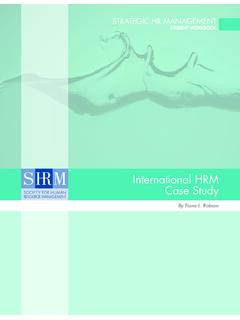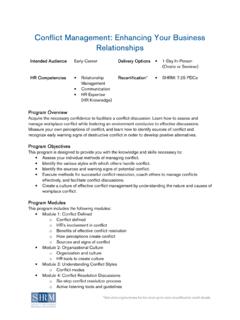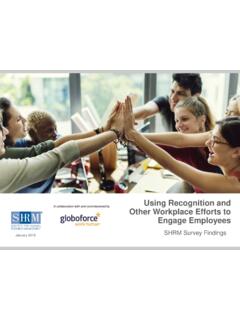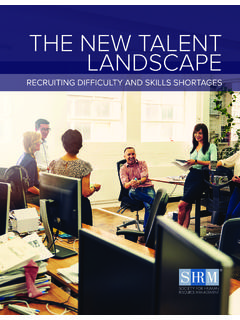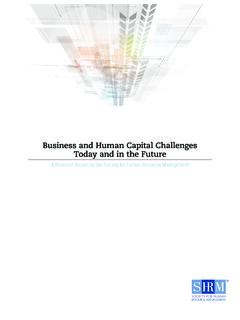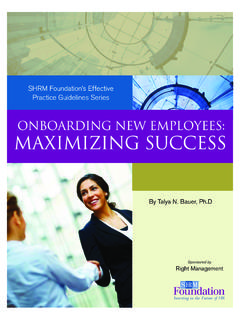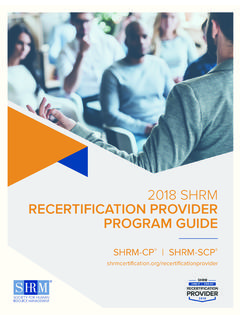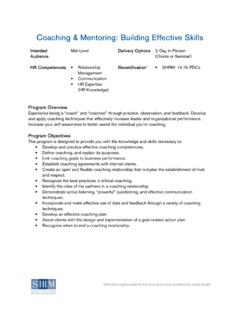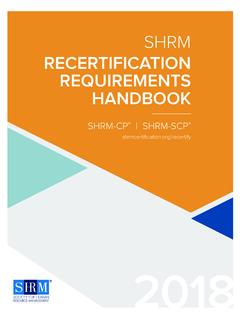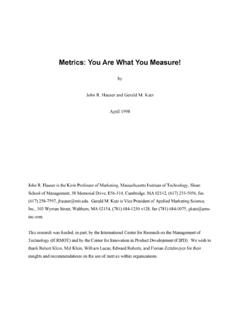Transcription of WORKFORCE ANALYTICS: A CRITICAL EVALUATION How ...
1 How organizational staff size Influences HR MetricsWORKFORCE ANALYTICS: A CRITICAL EVALUATIONA bout SHRMF ounded in 1948, the Society for Human Resource Management (SHRM) is the world s largest HR membership organization devoted to human resource management. Representing more than 275,000 members in over 160 countries, the Society is the leading provider of resources to serve the needs of HR professionals and advance the professional practice of human resource management. SHRM has more than 575 affiliated chapters within the United States and subsidiary offices in China, India and United Arab Emirates. Visit us at For more information about the SHRM/SHRM Foundation Older Workers initiative, visit and report is published by the Society for Human Resource Management (SHRM). All content is for informational purposes only and is not to be construed as a guaranteed outcome. The Society for Human Resource Management cannot accept responsibility for any errors or omissions or any liability resulting from the use or misuse of any such information.
2 2015 Society for Human Resource Management. All rights reserved. Printed in the United States of America. This publication may not be reproduced, stored in a retrieval system or transmitted in whole or in part, in any form or by any means, electronic, mechanical, photocopying, recording or otherwise, without the prior written permission of the Society for Human Resource more information, please contact: SHRM Research Department 1800 Duke Street, Alexandria, VA 22314 Phone + | ANALYTICS: A CRITICAL EVALUATIONI ntroductionHR professionals who move to a new organization that is larger or smaller than their previous organization often find changes in HR metrics . As companies grow in size , organizational life cycle theory suggests they face a range of problems, including HR For example, in small start-up organizations, when the focus is on firm survival, HR practices may appear unstructured and lack documentation, which can increase risk should a hiring decision or employment termination be legally challenged.
3 Large organizations, which usually have established business strategies to reliably produce revenue, often institute formal business practices (such as formal job descriptions, established pay scales and standardized performance reviews) to manage that risk. Generally as staff size grows and organizations become complex, the HR function becomes more formalized and In addition to staff size , the type of industry can often drive changes in HR metrics . In high-tech firms, where the demand for technical skills is high but available talent is low, cost-per-hire (CPH)3 is $4, This CPH is high when compared with the food services and accommodations industry, which has a low CPH of $2,9675 because the skills and talent are readily in HR and other functional areas attempt to fit policies and processes to business needs, yet the business needs vary depending on organizations stages of HR professionals work to implement new systems to help facilitate the success of those initiatives, often requiring significant change management support.
4 HR professionals who work in small, medium or large organizations know staff size affects how they go about implementing HR initiatives. For example, implementing an employee appraisal system for a single-site organization of 100 employees is vastly different than implementing a system across multiple sites totaling 5,000 employees. However, as HR practices change to fit and support organizations size and business environments, HR professionals may be unaware that key HR metrics also change. In this report, although the type of industry contributes to changes in HR data, the findings only focus on how changes in organizational size affect HR noted otherwise, results presented in this report are from the 2014 SHRM Human Capital Database of over 2,000 organizations. Key HR metrics were compared against organizations of small (1-250 employees), medium (251-1,000 employees) and large (1,001-10,000 employees) staff This report examines the following HR areas: HR-to-employee ratio.
5 Percentage of HR staff in supervisory roles. HR-expense-to-FTE (full-time equivalent) ratio. Use of structured interviews. Time-to-fill. Employee Ratio The HR-to-employee ratio compares HR staffing levels between organizations by showing the number of HR FTEs supporting 100 FTEs in an The average HR-to-employee ratio was for all organizations. As staff size increases, however, the HR-to-employee ratio decreases. For example, small organizations had a significantly higher HR-to-employee ratio of , compared with medium and large organizations that had ratios of and , A large HR-to-employee ratio for small organizations suggests that it takes a minimum number of HR employees to deliver core HR services, such as recruiting, benefits and employee relations. But once a minimum number of HR staff members are hired, the incremental amount of HR FTEs required to support large organizations does not increase at the same rate.
6 There are various reasons this difference in ratios exists as organizational size increases. First, although the ratio is smaller for larger organizations, the actual number of HR staff is greater. With more HR staff , there is more flexibility to offset peak work demands in one HR area with staff from another. For example, during the labor-intensive process of recruiting, if extra help is needed, it is easier to temporarily pull HR FTEs from other functional areas, such as employee relations or benefits, for additional support. Second, roles for HR professionals in firms with large numbers of employees usually have higher degrees of specialization. In large organizations, HR departments may have multiple benefits professionals, but even within the benefits area, one FTE may be dedicated solely to managing retirement planning and another to managing health care. Such role specificity allows for greater efficiency and economies of scale, because more roles require more effort and more time to switch between tasks that are different from each Third, many HR departments have less staff because they outsource HR functions to a preferred employer organization (PEO) or other HR outsourcing vendors.
7 When this occurs, the HR-to-employee ratio may decline, but actual HR expenses may go up to pay for outsourcing costs. FIGURE 1. AVERAGE EMPLOYEE-TO-HR RATIO, BY staff SIZES ource: WORKFORCE Analytics: A CRITICAL EVALUATION : how organizational staff size influences hr metrics (SHRM, 2015)1-250 ,000 ,001-10,000 of HR staff in Supervisory Roles The percentage of HR staff in supervisory roles ( , supervisor, manager, director or above) is calculated by taking the number of HR supervisory positions (FTEs) and dividing it by the total number of HR staff (FTEs). When organizations design their HR departments, this is a useful metric to benchmark the number of supervisory staff members other organizations in their industry use to implement the HR function. The percentage of HR staff in supervisory roles was 53% for all organizations. As the organization staff size grows, this percentage decreases in a similar way that HR-to-employee ratios decrease.
8 Small organizations had a significantly higher percentage of supervisory HR staff (65%) compared to medium (38%) and large (31%) This metric for medium organizations was also significantly higher than for large organizations, suggesting that the percentage of HR supervisory staff is sensitive to changes in staff size . Small organizations may have a higher percentage of supervisory staff because organizations may first hire supervisory talent to lead a functional HR area, such as employee relations or benefits, and then hire less-experienced staff if more resources are required. The fact that medium and large organizations have lower percentages of HR staff in supervisory roles also suggests that as organizations grow, supervisory HR staff members have capacity to increase their span of control by having more HR FTEs reporting to them, both directly and 2. AVERAGE PERCENTAGE OF HR staff IN SUPERVISORY ROLES, BY staff SIZES ource: WORKFORCE Analytics: A CRITICAL EVALUATION : how organizational staff size influences hr metrics (SHRM, 2015)31%1,001-10,000 FTEs251-1,000 FTEs38%1-250 FTEs65%Overall53%4HR-Expense-to-FTE Ratio The HR-expense-to-FTE ratio represents the amount of human resource dollars spent per FTE in the The average HR-expense-to-FTE ratio for all organizations was $2,986.
9 As organizations grow in staff size , the total costs of the HR function increase. HR expenses for small, medium and large organizations were $306,044, $840,015 and $3,393,775, Although total HR costs increase when staff size grows, the amount of HR dollars spent per employee decreases. Small organizations had significantly higher HR-expense-to-FTE ratios ($3,592) than medium ($1,897) and large organizations ($1,427).14 Such results suggest that early development of the HR function in small organizations requires higher infrastructure and outside consulting investments. Such investments may include an applicant tracking system, performance management software or external recruiting support, which once purchased can cost-effectively scale to support larger organizations so that HR expense per FTE declines. In essence, as organizations increase in size , they are able to disperse total HR costs among more 3.
10 AVERAGE HR-EXPENSE-TO-FTE RATIO, BY staff size Source: WORKFORCE Analytics: A CRITICAL EVALUATION : how organizational staff size influences hr metrics (SHRM, 2015)1-250 FTEs$3,592251-1,000 FTEs$1,8971,001-10,000 FTEs$1,427 All FTEs size $2,9865 Structured Interviews for Selecting Talent Selecting new talent for organizations is a CRITICAL HR function. Organizations that consistently bring on new hires whose knowledge, skills and abilities align with their firms overall strategy and culture outperform their Structured interviews in which candidates interviewing for the same position are asked similar questions based on job content have been shown to improve interview reliability and Structured interviews prevent the interviewer from asking different questions depending on the job candidate, thus limiting interviewer bias and avoiding skewing the EVALUATION of the candidates. Seventy-three percent of all organizations used structured interviews as part of their selection process.
